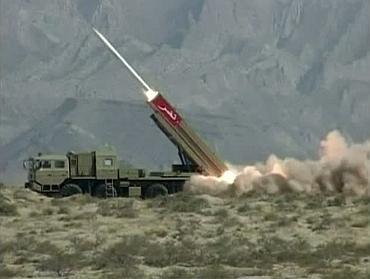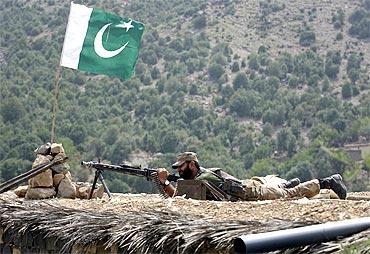 | « Back to article | Print this article |
The case of Pakistan's tactical nuclear weapons
With India's growing conventional capabilities and more pro-active military plans, Pakistan's military authorities have begun to emphasise the utility of tactical nuclear weapons, says Michael Krepon
Of all categories of nuclear weapons, those with the shortest ranges have the least military utility and pose the greatest problems relating to security and unauthorised use. Generally speaking, the smaller the nuclear weapon and its means of delivery, the more susceptible it is to loss of central control. The less control leaders have over nuclear weapons, the more likely they are to be used.
Tactical nuclear weapons, like the sixty kilometer Nasr (or Hatf IX) missile that Pakistan has flight tested, are not very helpful in stopping tank offensives or against fast-moving targets, and they are clearly excessive for blowing up railheads and bridges – even if they were within reach. Very limited use of tactical nuclear weapons might serve to warn India against advancing deeper into Pakistani territory. But the job of Pakistan's armed forces is to prevent mushroom clouds on home soil, not to create them.Whatever limited military utility short-range nuclear weapons possess depends on extreme forward deployments, where they would be most subject to attack, where early use would be most likely, and where command and control is most susceptible to breakdowns. Avoiding these pitfalls on the subcontinent depends on very slow moving fronts and the absence of air power. The first assumption is not unreasonab#8804 the second is extremely questionable.
Click NEXT to read further...
Any use of a nuclear weapon would have strategic consequences
There are also heightened internal security risks associated with tactical nuclear weapons. A cautionary tale from the Cold War might clarify these risks. In January 1977, members of the Baader-Meinhof gang, also known as the Red Army Gang, stormed a nuclear weapon storage facility in Giessen, West Germany.
This left-wing militant group sought to penetrate the base's storage vaults and seize control of a weapon by creating a diversion, blowing up a fuel tank outside the base perimeter. Gang members managed to penetrate the base perimeter, but after an exchange of gunfire, they were stopped short of the nuclear weapon storage area.
After testing nuclear devices in 1998, Indian and Pakistani spokespersons downplayed the value of short-range weapons. Instead, Pakistani military officers stressed that any use of a nuclear weapon would have strategic consequences.
This conclusion is sensible. It also greatly undermines the case for tactical nuclear weapons. Why risk crossing this momentous threshold with hard-to-defend and hard-to-control short-range delivery systems when more survivable and controllable longer-range nuclear forces are available for use in extreme circumstances?
With India's growing conventional capabilities and more pro-active military plans, Pakistan's military authorities have begun to emphasise the utility of tactical nuclear weapons. In typical fashion, New Delhi is moving very slowly to gain these capabilities for successful, limited war options against well-defended territory. While India's Army continues to face many shortfalls, its Air Force is being qualitatively upgraded.
Click NEXT to read further...
History of wars on the subcontinent rife with miscalculation
India's nuclear program is firmly controlled by civilians who view the Bomb as a political instrument. Pakistan's nuclear program is run by military officers who think of the Bomb in military terms, and who are methodically filling in perceived shortfalls in nuclear capabilities as a means to shore up deterrence against a stronger neighbour. The most likely need for deterrence is after iconic targets in India are attacked by individuals based and trained in Pakistan.
Pakistani leaders do not announce their nuclear doctrine. Instead, those in authority use press releases and the occasional interviews to make essential points. In defence of their need for tactical nuclear weapons, Pakistani interlocutors point to NATO's strategy during the Cold War or dealing with a conventionally superior foe. The thousands of tactical nuclear weapons deployed by the United States and the Soviet Union during the Cold War could have resulted in stories with tragic endings. Instead, we were all lucky.
Maybe Pakistan and India will also be lucky. But the history of wars on the subcontinent is rife with miscalculation, as one side or the other has repeatedly been surprised by the beginning and prosecution of wars. No surprise could be more deadly or consequential than the use of nuclear weapons in warfare for the first time since 1945. Other deadly surprises are then sure to follow.
TOP photo features of the week
Click on MORE to see another set of PHOTO features...




